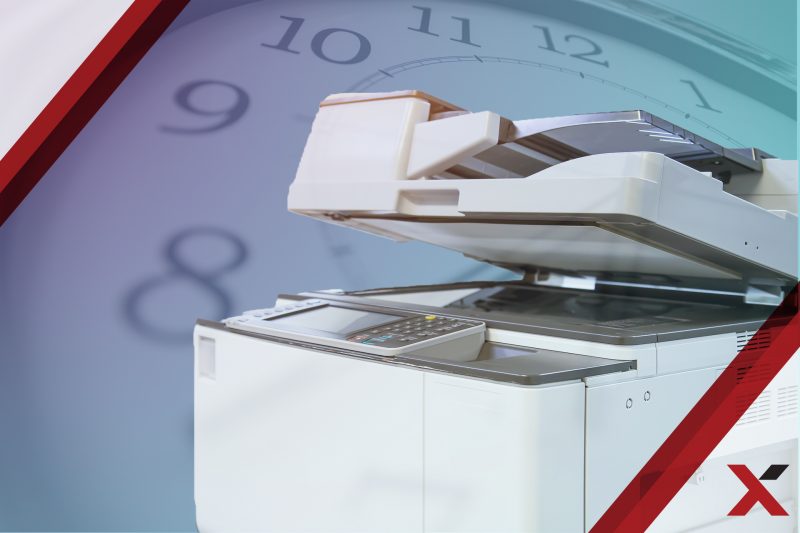How long should your office copier or printer last? While the typical lifespan of an office copier, printer, or multi-purpose device ranges from 3 to 5 years, the rapid pace of technological advances from printer manufacturers often makes upgrading every three years the most practical choice for many businesses.
Let’s explore why.
Why You Should Upgrade Every Three Years
Technology in the office copier and printer space is constantly evolving, offering significant improvements with each new generation. These advancements make older models inefficient in comparison. Consider the benefits of upgrading:
- Faster printing speeds: Newer models print significantly faster, increasing overall productivity.
- Sustainability: Modern printers use less energy and generate less waste, making them environmentally friendly.
- Cost efficiency: Newer models often have a lower total cost of ownership due to advancements in toner cartridges and inkjet cartridges technology.
- Advanced features: Cloud printing, mobile integration, and enhanced security features make modern printers much more versatile.
With these advancements, continuing to use an outdated copier can cost more in maintenance and productivity losses than upgrading to a more modern, efficient machine.
The Liabilities of Sticking with an Older Printer
When you hold onto older office printers or copiers beyond their optimal lifespan, several issues can arise:
- Compatibility problems: Older copiers often face compatibility issues with newer software, cloud applications, and operating systems, leading to workflow disruptions.
- End of Life (EOL): As printers reach their End of Life (EOL), manufacturers stop providing support and updates, making it harder to source replacement parts and increasing the risk of failure.
- Security risks: Without regular printer firmware updates, older machines become susceptible to cyberattacks. Since office printers are networked devices, they can become entry points for hackers, putting sensitive company data at risk.
Problems Connected to Older Printers
Older office copiers and printers often come with a host of performance issues. Here’s a list of common problems you’re likely to encounter as they age:
- Frequent paper jams
- Streaks or faded prints
- Slower printing speeds
- Higher ink or toner consumption
- Inconsistent wireless connectivity
- Limited functionality for modern workflows
Once these issues start piling up, replacing the old equipment is usually more cost-effective than continuing to invest in repairs.
Make Your Life Easier: The Benefits of a Synchronous Lease Cycle
Managing a print fleet can become complex when different devices are on different lease schedules. By maintaining a synchronous lease cycle for your entire fleet (or at least segments of it), you simplify fleet management in several ways:
- Consistency: All devices will be upgraded at the same time, ensuring uniform technology across your fleet.
- Simplified maintenance: Having a consistent fleet means fewer compatibility issues, easier repairs, and streamlined support.
- Cost predictability: A synchronized leasing cycle allows you to plan and budget for upgrades and maintenance more efficiently.
By keeping your fleet on a synchronized lease schedule, you reduce administrative headaches and ensure your technology stays up-to-date.
Simplify Print Fleet Management with Managed Print Services (MPS)
One of the most effective ways to simplify print fleet management is by partnering with a managed print services (MPS) provider. Having a single point of contact for all print-related needs not only reduces complexity but also frees up your IT team to focus on more critical tasks.
An MPS provider can handle everything from routine maintenance and printer firmware updates to troubleshooting and managing supplies like inkjet cartridges and toner cartridges.
With a managed print services provider, you benefit from:
- Centralized management: One point of contact for all your printer needs, reducing the need to work with multiple vendors.
- Proactive monitoring: MPS providers often use remote monitoring to spot issues before they affect your business, reducing downtime.
- Cost control: Managed print services help you track usage, optimize workflows, and reduce unnecessary printing, leading to lower overall costs.
Let A Managed Print Services (MPS) Provider Handle Your Renewables
Managing printer supplies like toner cartridges and inkjet cartridges can become a hassle, especially in large offices with multiple devices. Letting your managed print services provider automate the renewal of these supplies ensures that you never run out, saving both time and resources.
Benefits of automated supply management include:
- No more manual orders: Automated supply ordering eliminates the risk of running out of ink or toner at critical moments.
- Optimized inventory: Your MPS provider can ensure you only stock what you need, avoiding excess supplies that may go unused.
- Reduced downtime: By automating renewals, you can keep your office stocked with the supplies it needs, minimizing interruptions to productivity.
By allowing your MPS to manage these renewables, your office benefits from streamlined operations, predictable costs, and fewer disruptions.
Should You Lease or Buy Your Printers?
Whether to lease or buy your office printers is another important decision. Leasing offers several benefits:
- Lower upfront costs: Spread the equipment cost over the lease term, avoiding large upfront expenses.
- Regular upgrades: Leasing ensures you can regularly upgrade your printing devices to newer models, keeping your fleet modern and efficient.
- Simplified budgeting: Fixed monthly costs make budgeting easier and more predictable.
On the other hand, purchasing may make sense for businesses that prefer owning their assets outright and are comfortable handling repairs and upgrades in-house.
Is It Time to Upgrade Your Office Copier or Printer?
With advances in print technology, keeping older office copiers beyond their optimal lifespan can become more of a burden than a benefit. By upgrading your office printing devices every three years, maintaining a synchronous lease cycle, and working with a managed print services (MPS) provider, you can save time, reduce costs, and enhance productivity.
A managed print provider can also simplify fleet management and automate supplies like toner and inkjet cartridges
Are your office printers overdue for an upgrade?
Reach out to us; let’s do an assessment of your print fleet.
We may save you a ton of money on annual operational spend. (We often do!)
